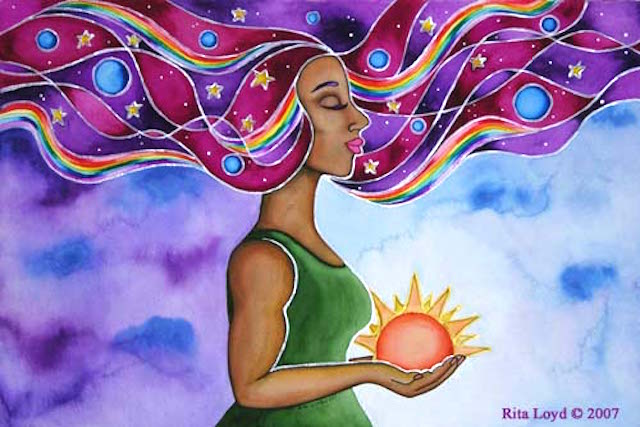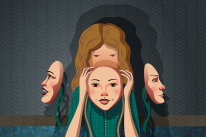
“Love is the great miracle cure. Loving ourselves works miracles in our lives.” ~Louise L. Hay
When I first began painting my art over twenty years ago, it was not my intention to paint about self-love. In fact, at that time, I had no idea what self-love was. I was just painting as a form of therapy.
A few years prior, I thought that I did know what self-love was, but then, when I lost my health to a chronic illness and could no longer do the things I once had been able to do, I lost my ability to love myself. I also fell into a deep depression, so I decided to create art as a way to lift my spirits.
In order to create uplifting art, I first had to look at my life and see where my spirit needed lifting. That meant that I had to look at my pain and identify its origins.
Sometimes it’s not the actual problems in life that cause us to suffer the most but the way we look at them. When we change our perspective, some of the suffering can diminish. So, I would look at one problem in my life at a time, and then I would search my spiritual studies for advice, and that advice is what I would paint.
I continued with this process for about nine years, and then one day I made a discovery that would change my life forever.
I was drawing the image of a woman with words of encouragement all around her, and then I suddenly realized that these words were messages of self-love. And then I realized that all of my paintings were messages of self-love. But how could this be? I thought that I didn’t know what self-love was.
I couldn’t see before that my art was about self-love because I was so focused on creating one painting at a time. But now I could see that each painting was a reflection of my journey in search of self-love.
Even more amazing was that I could see that my creative process was teaching me how to love myself, and it did this by giving me a setting and the reason to:
- Slow down
- Look inward
- Ask myself questions and listen for answers
- Seek new solutions
- Be kind and patient with myself
- Value my opinion
- Trust in my instincts
- Embrace my sensitivity
- Forgive my mistakes
- Quiet my inner critic
- Give myself a voice and allow myself to speak
Now that I could understand what self-love was, at least within the boundaries of creating my art, I felt motivated to examine self-love further in order to incorporate it into all areas of my life.
As I explored my thoughts about self-love and with the influence of Wayne Dyer’s book entitled Sacred Self, I came to the conclusion that there are two kinds of self-love.
There is ego-based self-love and there is spirit-based self-love. The former cares about what the ego cares about—appearances, power, and survival. The latter cares about what the spirit cares about—healing, wholeness, and love.
Early on, when I lost my ability to love myself, I could feel how conditional my self-love was. And now I can see that the reason for that was because my self-love was ego-based. But now I was ready for unconditional self-love, which is a love that never abandons us.
Before I lost my self-love due to illness, life was going great. But when I got sick and lost everything (except my wonderful now-husband), my ego judged me as a failure and worthless because its love was conditional. My life had to look a certain way before my ego would allow me to love myself. And then, when my ego became displeased, it activated the voice of my inner critic.
From the wreckage of my life, even my ego eventually gave up on me, and in its silence, the gentle voice of my spirit could finally be heard. It guided me to paint art as a form of therapy. And within the quiet space of creating art, it became a spiritual experience that drew me closer to my spirit’s voice.
Before I found true self-love (spirit-based self-love), I thought self-love was about pampering ourselves, for example, by buying a new outfit, getting a manicure, or going on vacation in order to feel happy. Pampering is not a bad thing if we can afford it, but it does become self-sabotage if we can’t.
Pampering is more about distracting ourselves from our problems rather than looking at them and dealing with them.
Real self-love is not about anything you can buy; therefore, it is available to everyone. Real self-love is about healing, helping, supporting, and empowering ourselves. It’s about examining what we believe about life and ourselves, and then challenging those beliefs to see if they are truly beneficial to our health and happiness.
The goal of unconditional self-love is to live our best life with a sense of wholeness, health, peace, and empowerment. Empowerment enables us to change our lives for the better and to make the world a better place.
Before I found self-love, I used to be a lot more critical with myself. For example, I hated how sensitive I was because my sensitivity caused me to experience depression, anxiety, and panic attacks. This sensitive nature made me feel stupid, worthless, and weak.
But when I began to love myself, I began to look at the positive side of my sensitivity—that it gave me the ability to understand things on a deeper level and to create meaningful art that touches the hearts of others.
Another area where self-love improved in my life was that it influenced me to make better relationship choices. My first marriage was emotionally abusive, and I stayed in it because I felt addicted to the relationship and I felt that, on some level, I didn’t deserve real love. But as my self-worth grew from reading self-help books, I was eventually able to leave and find a wonderful love with my husband, Jody.
For me, my biggest obstacle to self-love was just not knowing what self-love was. Now that I know what it is, I can realign myself with unconditional self-love just by catching myself when I start to treat myself unfairly and reminding myself that I deserve my own love and support.
Here are some of the key points that I have discovered about self-love:
Self-love is about the relationship that we have with ourselves. It’s about speaking to ourselves, treating ourselves, and seeing ourselves with kindness, forgiveness, fairness, encouragement, patience, and helpfulness.
Self-love is about paying attention to what we need in all areas of our lives instead of ignoring, avoiding, or neglecting those needs.
Self-love is a gradual and growing process that deepens and matures over our lifetime. It’s normal to get distracted away from self-love. It’s natural to go back and forth, forgetting and then remembering to love ourselves. But as we continue to practice self-love through the years, those lapses of self-love become shorter in duration and farther apart.
Self-love is not about standing in front of ourselves as a judge who shames and condemns us. True self-love is about walking beside ourselves in harmony and, as a true friend, supporting ourselves along life’s entire journey.
Artwork by the author, Rita Loyd. Check out her Unconditional Self-Love Message Card Deck here.
About Rita Loyd
Rita Loyd is a writer and a watercolor painter dedicated to teaching unconditional self-love. Through her website, NurturingArt.com, she offers a variety of tools to support your self-love journey—including two inspirational books, an unconditional self-love message card deck, and a colorful greeting card line.













 Though I run this site, it is not mine. It's ours. It's not about me. It's about us. Your stories and your wisdom are just as meaningful as mine.
Though I run this site, it is not mine. It's ours. It's not about me. It's about us. Your stories and your wisdom are just as meaningful as mine. 
24 Responses to What Unconditional Self-Love Looks Like